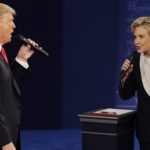 Live televised debates have become a staple of the political scene during elections across the western world in recent years, with millions typically tuning in to hear the candidates grilled on various key policy matters.
Live televised debates have become a staple of the political scene during elections across the western world in recent years, with millions typically tuning in to hear the candidates grilled on various key policy matters.
New research from Georgia State utilized facial recognition software to assess whether men and women had the same kind of response to the debates. They believe that using live facial analysis provides a better insight into the minds of viewers than post-debate interviews or even real-time self-reporting, which are the most commonly used methods today.
Viewers were recorded with webcams as they watched the debate, with facial recognition software then used to provide a frame-by-frame analysis of the facial expressions and emotions displayed by each viewer. The technology was able to track 20 unique facial movements, such as wrinkling the nose, frowning or furrowing the brow to detect emotions such as anger, sadness or disgust.
Gender divide
Interestingly, the analysis revealed a clear gender divide, with women displaying stronger emotions, not least on a range of gender-related issues that emerged during the debates.
“Women expressed internalizing emotions like sadness twice as often as men,” the researchers say. “Men expressed externalizing emotions like anger and disgust more often. There were also differences in when men and women expressed these emotions. Our data indicated that women’s expressions of sadness and men’s expressions of anger increased during periods when Clinton spoke more.”
The researchers suggest that gender was quite uniquely to the fore of the event,, due in large part to the fact that Clinton was the first woman to be nominated for President. The debate received the largest viewing figures of any US presidential debate, with a whopping 84 million people tuning in.
Gender had been a significant part of the presidential campaign, both because of Trump’s numerous remarks about women’s appearances and general sexist demeanor, and Clinton’s emphasis on her attempt to break the glass ceiling.
“We found that the impact of emotional expressions was more powerful for women than men in predicting post-debate evaluations of the candidates’ debate performance, particularly in their evaluations of Trump’s performance,” the researchers say. “For example, as women showed more expressions of fear, their ratings of Trump’s performance decreased significantly. However, as men expressed more fear, their evaluations of the candidates’ performance barely budged.”
The researchers believe such facial analysis is relatively new to political science, despite being a staple of marketing research for some time. They believe that it could play an ever more important role in politics and the crafting of political messaging in future.
“Now that we have the software, it would be interesting to look at how people are looking at different types of stimuli like speeches or ads or website messaging,” they conclude. “The broad question that we are concerned with for this study is, do debates matter? Are they educators for the population? The answer from our paper is that debates do matter in distinct and different ways for people watching them.”